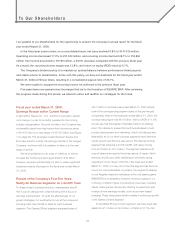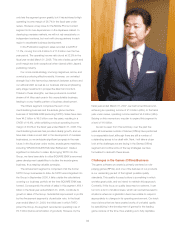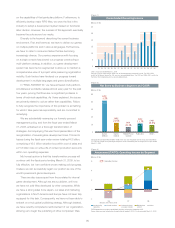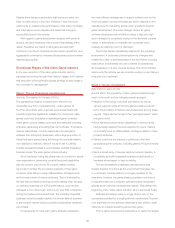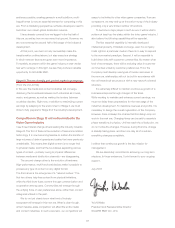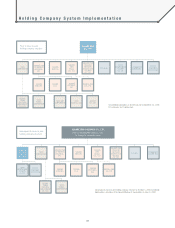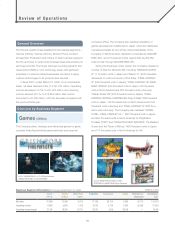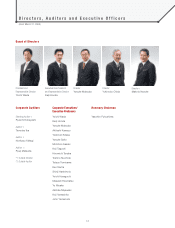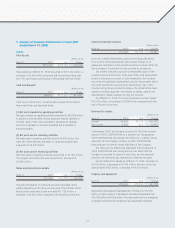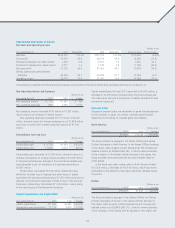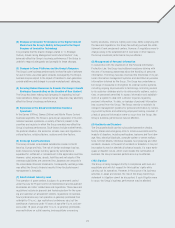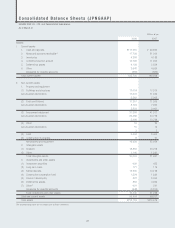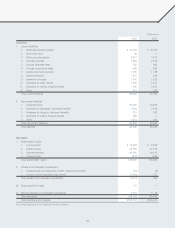Square Enix 2008 Annual Report Download - page 15
Download and view the complete annual report
Please find page 15 of the 2008 Square Enix annual report below. You can navigate through the pages in the report by either clicking on the pages listed below, or by using the keyword search tool below to find specific information within the annual report.
The Company has adopted the corporate auditor system for its corporate
governance. To strengthen monitoring functions and ensure the
maintenance of sound management, at least half of the corporate auditors
are drawn from outside the Company. Furthermore, in accordance with
the objective standards provided under the Company’s internal decision-
making authority rules, the Board of Directors, which sets management
policy, is clearly separated from the decision-making bodies responsible
for the execution of operations. This system aims to enhance the efficiency
and balance of management decision-making and operational execution.
(1) Management control structure and other corporate governance
systems relating to management decision-making, execution of
operations and audit functions
The Board of Directors comprises five directors, including one outside
director. The Company has four corporate auditors, all of whom are drawn
from outside the Company. There is one standing corporate auditor. The
directors are appointed for a term of one year, the same as for companies
adopting the committee system.
The Auditing Division reports directly to the president as an
autonomous internal unit currently comprising two members. The Auditing
Division performs regular monitoring and evaluation of internal control
systems, including those of Group companies, taking into account the
relative importance and risk inherent in each part of the organization, and
provides reports and recommendations to the president. The Auditing
Division’s functions are carried out while sharing information with the
Board of Auditors and the independent audit firm.
To ensure a rigorous compliance system, the Company clearly
specifies the importance of compliance in its management guidelines and
The Square Enix Group Code of Conduct. The Company has established
the Internal Control Committee and an internal compliance reporting
(whistleblower) system, through which Companywide compliance
measures are integrated laterally across organizational reporting lines. With
regard to the management and operation of the Company’s information
systems, which form the foundation of efficient operational functions, the
Company has established the Information System Management
Committee to oversee information systems on a companywide basis.
In principle, the Board of Directors convenes monthly, and each of the
directors, including one outside director, engages in vigorous discussion
and exchange of opinions aimed at enhancing their mutual oversight
functions.
In principle, the Board of Auditors convenes monthly, and conducts
accounting and operational audits based on the audit plan. The corporate
auditors attend meetings of the Board of Directors to audit the execution
of duties of the directors.
With regard to the use of independent outside professionals, the
Company consults with several outside legal counsels as necessary on
significant transactions and legal matters. The Company retains Ernst &
Young ShinNihon as its statutory audit firm under the Companies Act and
the Financial Instruments and Exchange Law to perform independent
third-party accounting audits. The Company fully cooperates with the
statutory audit firm to ensure smooth performance of their duties.
The following certified public accountants (CPAs) conducted audits of
the Company during fiscal 2007.
• CPAs performing audits:
Partners: Koichiro Watanabe, Kenichi Shibata, Tatsuya Yokouchi
• Personnel providing audit assistance:
8 CPAs and 15 assistant CPAs
Remuneration to directors and corporate auditors
Remuneration paid to directors totaled ¥243 million, of which ¥7 million
was paid to the outside director.
Remuneration paid to corporate auditors totaled ¥30 million, of which ¥30
million was paid to outside auditors.
Compensation to independent audit firm
Compensation paid to Ernst & Young ShinNihon for contracted services
prescribed under Article 2, Paragraph 1, of the Certified Public
Accountants Law amounted to ¥57 million.
(2) Personal, financial business or other relationships constituting
conflicts of interest between the Company and its outside
director or outside corporate auditors
There are no such relationships to be specified.
(3) Basic policy on the establishment of internal control systems
The Board of Directors has passed a resolution establishing the
Company’s Basic Policy on Building an Internal Control System. The
Company is building such systems to ensure auditing and supervisory
functions are strictly maintained and to confirm that all business activities
comply with all relevant laws and regulations and the Company’s Articles
of Incorporation, as well as to enhance the efficiency of the directors’
exercise of duties.
(4) Overview of liability limitation agreements
The Company has liability limitation agreements in place with its outside
director and outside corporate auditors in accordance with Article 427,
Paragraph 1, of the Companies Act to limit liabilities provided under Article
423, Paragraph 1, of the Companies Act. These agreements limit the
liability of the outside director and each outside corporate auditor to ¥10
million or the legally specified amount, whichever is greater, on condition
that the director or corporate auditors have performed their duties in good
faith and without gross negligence.
(5) Prescribed number of directors
The Company’s Articles of Incorporation stipulate that the number of
directors shall not exceed 12.
(6) Resolution requirements for the election of directors
The Company’s Articles of Incorporation stipulate that resolutions for the
election of directors shall be made by the majority of votes of shareholders
exercising their voting rights at the General Meeting of Shareholders
where shareholders in attendance hold one-third or more of outstanding
voting rights.
(7) Bodies able to determine dividends paid from retained earnings
The Company’s Articles of Incorporation stipulate that matters provided
under Article 459, Paragraph 1, of the Companies Act may be determined
by the Board of Directors unless legally stipulated otherwise. The objective
of this provision is to expand the range of options enabling flexible
execution of capital policies.
(8) Exemption from liability of directors and corporate auditors
Pursuant to Article 426, Paragraph 1, of the Companies Act, the
Company’s Articles of Incorporation stipulate that a director (including
former directors) may be exempted from liability for actions related to
Article 423, Paragraph 1, of the Companies Act, up to the limit provided
by law, through a resolution passed by the Board of Directors. This
provision aims to ensure the maintenance of an environment in which
directors may exercise their duties to the maximum of their abilities and
are able to fulfill the roles expected of them.
(9) Matters requiring special resolutions at the General Meeting of
Shareholders
The Company’s Articles of Incorporation stipulate that the special
resolutions provided under Article 309, Paragraph 2, of the Companies
Act may be passed by a majority of two-thirds or more of the votes of
shareholders present at the General Meeting of Shareholders where
shareholders in attendance hold one-third or more of outstanding voting
rights. The objective of this relaxation of special resolution requirements is
to ensure the smooth proceedings of the General Meeting of
Shareholders.
1. Basic Stance on Corporate Governance
2. Status of Implementation of Corporate Governance Policies
Corporate Governance
13


